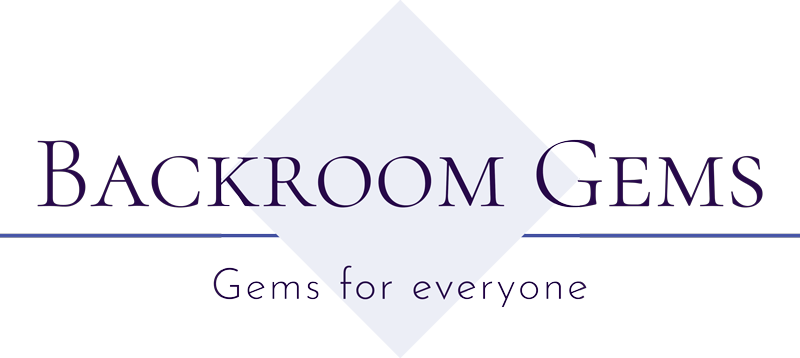Give Thanks for Citrine and Topaz
Leaves falling, gorgeous colors shifting with the temperature, and giving thanks are some of the things that may come to mind when thinking about November. Unless you love gemstones and crystals because then you are likely already putting out all of your citrine and topaz to display for turkey day. November babies are lucky enough to have these two stunning birthstones to choose from when picking out jewelry.
Citrine
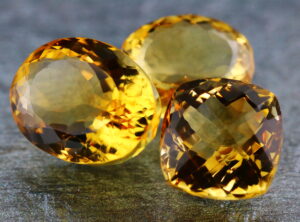 The first and most commonly used birthstone for November is citrine. This popular gem is the yellow variety of quartz that gets its color from traces of iron and its name from “citron,” the Old French word for lemon. Its hue ranges from a bright, juicy lemon yellow to rich shades of amber. Citrine has been used in jewelry for thousands of years dating back to ancient times where it was carried for protection against snake venom and evil thoughts. The Egyptians used the gems as talismans, the ancient Greeks carved iconic images into them and shaped them into ornaments, while Roman priests made them into rings.
The first and most commonly used birthstone for November is citrine. This popular gem is the yellow variety of quartz that gets its color from traces of iron and its name from “citron,” the Old French word for lemon. Its hue ranges from a bright, juicy lemon yellow to rich shades of amber. Citrine has been used in jewelry for thousands of years dating back to ancient times where it was carried for protection against snake venom and evil thoughts. The Egyptians used the gems as talismans, the ancient Greeks carved iconic images into them and shaped them into ornaments, while Roman priests made them into rings.  Citrine was particularly popular in colorful Scottish jewelry from the Victorian era and continued into the Art Deco era in the early 20th century, when Hollywood movie stars would wear elaborate citrine-adorned jewelry; a trend that has continued on the red carpet today. Fashion aside, citrine has been worn in hopes of improving blood circulation and strengthening the immune system. This healing gemstone is said to provide a calming, soothing, and comforting effect as well as spark imagination, encourage new beginnings, and help those suffering with seasonal affective disorder.
Citrine was particularly popular in colorful Scottish jewelry from the Victorian era and continued into the Art Deco era in the early 20th century, when Hollywood movie stars would wear elaborate citrine-adorned jewelry; a trend that has continued on the red carpet today. Fashion aside, citrine has been worn in hopes of improving blood circulation and strengthening the immune system. This healing gemstone is said to provide a calming, soothing, and comforting effect as well as spark imagination, encourage new beginnings, and help those suffering with seasonal affective disorder.
Natural or Heated?
All citrine in the world is formed when either amethyst or smoky quartz is superheated. This can either be done naturally in the Earth, or in a lab after the crystals are pulled from the dirt. The change of color happens at around 800-900 degrees Fahrenheit and the resulting color is directly related to the richness of the original crystal’s hue. Natural citrine is a result of geothermal heat in the mantle that transforms the gems before they are ever found by human hands. Heat-treated citrine is formed in a lab by “baking” the quartz, mimicking the Earth’s natural process. If you have access to a kiln, you can create your own citrine at home as long as you’re willing to say goodbye to your amethyst or smoky quartz.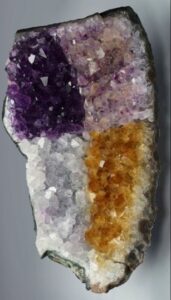 Natural citrine is more rare than heated citrine, so a good percentage of this gem on the market is heated. It still stems from a natural crystal; it just needed a little help getting its color. Much like all of us go to the beach to get a little color!
Natural citrine is more rare than heated citrine, so a good percentage of this gem on the market is heated. It still stems from a natural crystal; it just needed a little help getting its color. Much like all of us go to the beach to get a little color!
Top Left: Untreated, natural amethyst
Top Right: Exposed to heat (380°C or 716°F for 8 hours)
Bottom Left: Exposed to UV light
Bottom Right: Exposed to heat (450°C or 842°F for 12 hours)
 Citrine, like many other gemstones, has fallen victim to misidentification in years past being often confused with its November birthstone counterpart, topaz. As a result of this, people believed citrine had some of the same powers and properties as topaz. Both thought to have calming energies while bringing fortune and warmth to the wearer. It is also one of the most abundantly available, most affordable, and desired yellow gemstones so there should be no trouble finding jewelry or specimens to give your spouse for your 13th anniversary, or for the Scorpio or Sagittarius in your life.
Citrine, like many other gemstones, has fallen victim to misidentification in years past being often confused with its November birthstone counterpart, topaz. As a result of this, people believed citrine had some of the same powers and properties as topaz. Both thought to have calming energies while bringing fortune and warmth to the wearer. It is also one of the most abundantly available, most affordable, and desired yellow gemstones so there should be no trouble finding jewelry or specimens to give your spouse for your 13th anniversary, or for the Scorpio or Sagittarius in your life.
Topaz
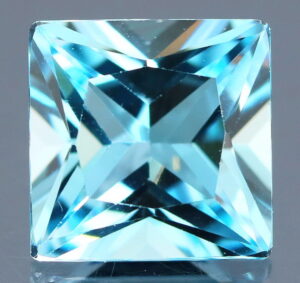 If your birthday lands in November and you are not a fan of yellow, have no fear! There is another gemstone representing your month that comes in a whole rainbow of colors and is still just as affordable. In its natural state, topaz is typically colorless, though it can sometimes naturally display pale blue, golden brown, or yellow orange colors. While it is most common to think of blue topaz (the gem for the 4th wedding anniversary), the gem actually comes in a wide range of hues. These luscious hues that fill the market are often treated gems by either heat or radiation; a common practice that creates the desirable birthstone gems. The different types of topaz are categorized by color, however there are a few specific types that have broader names such as Imperial topaz or Sherry topaz, named after the sherry wine. There are many legends that surround topaz throughout history. For example, ancient Romans believed that it could provide protection from danger while traveling, while Englishmen thought that it could cure lunacy. Ancient Greeks believed that topaz gave them strength, and from the 1300s to the 1600s, Europeans thought the gem could thwart magic spells and dispel anger. In the Middle Ages, it was thought that attaching the gem to the left arm could protect the wearer from any curse and would ward off the evil eye while enhancing mental powers.
If your birthday lands in November and you are not a fan of yellow, have no fear! There is another gemstone representing your month that comes in a whole rainbow of colors and is still just as affordable. In its natural state, topaz is typically colorless, though it can sometimes naturally display pale blue, golden brown, or yellow orange colors. While it is most common to think of blue topaz (the gem for the 4th wedding anniversary), the gem actually comes in a wide range of hues. These luscious hues that fill the market are often treated gems by either heat or radiation; a common practice that creates the desirable birthstone gems. The different types of topaz are categorized by color, however there are a few specific types that have broader names such as Imperial topaz or Sherry topaz, named after the sherry wine. There are many legends that surround topaz throughout history. For example, ancient Romans believed that it could provide protection from danger while traveling, while Englishmen thought that it could cure lunacy. Ancient Greeks believed that topaz gave them strength, and from the 1300s to the 1600s, Europeans thought the gem could thwart magic spells and dispel anger. In the Middle Ages, it was thought that attaching the gem to the left arm could protect the wearer from any curse and would ward off the evil eye while enhancing mental powers.
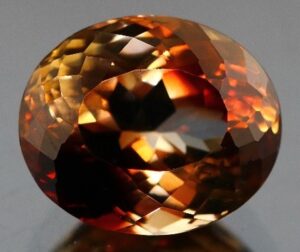 Imperial topaz has an aristocratic reputation with its distinct golden to reddish orange or pink hue. The hues tell a story of the golden sun setting into a fiery hue and then rising with the pink of first light with an incredible brilliance. Interestingly, there is some speculation as to where the gem originated, but it is most commonly thought to have been named in honor of Brazilian Emperor Dom Pedro. This is fitting as it is primarily found in Ouro Preto, Brazil. Another popular legend finds the uniquely hued gem in 19th century Russia where it was mined in the Ural Mountains and named to honor the Russian czar. Its use restricted to the royal family adorning Tsarinas.
Imperial topaz has an aristocratic reputation with its distinct golden to reddish orange or pink hue. The hues tell a story of the golden sun setting into a fiery hue and then rising with the pink of first light with an incredible brilliance. Interestingly, there is some speculation as to where the gem originated, but it is most commonly thought to have been named in honor of Brazilian Emperor Dom Pedro. This is fitting as it is primarily found in Ouro Preto, Brazil. Another popular legend finds the uniquely hued gem in 19th century Russia where it was mined in the Ural Mountains and named to honor the Russian czar. Its use restricted to the royal family adorning Tsarinas. 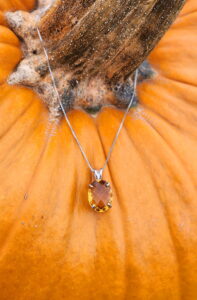 Imperial topaz is a very powerful manifestation stone, and it is thought to enhance one’s personal will, attract prosperity, as well as supporting visualization, creativity, and generosity. It is also representative of the 23rd wedding anniversary, so make sure you don’t forget to gift this royalty-worthy gemstone!
Imperial topaz is a very powerful manifestation stone, and it is thought to enhance one’s personal will, attract prosperity, as well as supporting visualization, creativity, and generosity. It is also representative of the 23rd wedding anniversary, so make sure you don’t forget to gift this royalty-worthy gemstone!
Whether you are looking for yourself or for a loved one, you can’t go wrong with either of these two gems. They are both plenty durable for everyday wear in jewelry and are stunning in any setting. Tell them they are the light of your life with a bright, lemon-yellow citrine or show them that they are royalty in your mind with a rich Imperial topaz. Either way, visit Backroom Gems to pick out the perfect gem!
